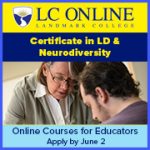Introduction
Learning disabilities (LD), sometimes referred to as “specific learning disorders,” are life-long, but adults who have LD can experience great success in all aspects of life when using their strengths together with the strategies, accommodations and technology that are most appropriate and effective for their individual needs.
What are learning disabilities?
Learning disabilities are neurological disabilities that affect information processing. They may affect how a person learns, understands, communicates, and remembers information. Adults with LD may have been born with their disability, or they may have acquired it later in life.
LD affects men and women equally.
There is neither one type of learning disability nor one profile for adults with learning disabilities. There are many different patterns of difficulties. For example, one adult may have a serious reading disability, while another may be able to read adequately, but not be able to communicate thoughts in writing or have difficulty with math. Most people with LD (85%) have a reading disability, or dyslexia (The Neurobiology of Reading and Dyslexia, by Sally E. Shaywitz, M.D., and Bennett A. Shaywitz, M.D.). Some adults with LD will have difficulty with self-control, perceiving social situations appropriately, and getting along with other people.
Learn more about the types of learning disabilities here.
Learning disabilities are not related to low intelligence. In fact, most people with learning disabilities have average to above average intelligence, but the impact of the disability may impair their ability to function well in school, at home, or in the workplace.
How are adults diagnosed with LD?
A specific learning disorder is diagnosed through a clinical review of the individual’s developmental, medical, educational, and family history, reports of test scores and teacher observations, and response to academic interventions (Specific Learning Disorder fact sheet, American Psychiatric Association, 2013). The evaluator must be licensed to evaluate LD; typically, LD evaluations are conducted by psychologists, psychiatrists, neuropsychologists, licensed psychological counselors, or school psychologists.
Learn more about the adult assessment process.
What causes LD?
Experts aren’t exactly sure what causes learning disabilities. Some possibilities include:
- Heredity: Learning disabilities often run in the family, so many people with learning disabilities have parents or other relatives with similar difficulties.
- Problems during pregnancy and birth: Learning disabilities may be caused by illness or injury during or before birth. It may also be caused by low birth weight, lack of oxygen, drug and alcohol use during pregnancy, and premature or prolonged labor.
- Incidents after birth: Head injuries, nutritional deprivation, and exposure to toxic substances can contribute to the development of learning disabilities.
However, LD is NOT caused by economic disadvantage or cultural differences. (http://www.pbs.org/parents/education/learning-disabilities/basics/causes/)
Characteristics of adults with LD
Positive characteristics of adults with LD may include problem-solving skills, compensatory strategies, persistence, empathy, and outgoing personalities. Areas of difficulty include:
- difficulty with reading, writing and/or math;
- poor memory;
- difficulty following directions;
- inability to discriminate between or among letters, numbers, and/or sounds;
- eye-hand coordination problems;
- difficulty putting things in the right sequence;
- disorganization; and/or
- difficulty adjusting to change.
Legal rights of adults with LD
Adults with LD are protected by several civil rights laws, including the Rehabilitation Act of 1973, Section 504; the Americans with Disabilities Act (ADA) of 1990 and the ADA Amendments Act (ADAAA) of 2008; and the Workforce Innovation and Opportunity Act 2015, Subtitle F, Rights and Advocacy. In addition to these laws, the 5th and 14th Amendments to the Constitution provide equal protection under the law related to governmental actions.
Learn more about the ADA and accommodations in the workplace.
Strategies, Accommodations and Technology
Typical strategies and accommodations that may help adults with LD include reading out loud, audio texts, color-coding for organization, use of graphic organizers (charts, diagrams, etc.), having opportunities to re-state information in one’s own words, and one-on-one instruction in school or job training. Assistive technology (AT) is also helpful for adults with LD – at home, school, and work. You can find free or low cost assistive technology apps through Georgia Tech’s Tools for Life App Finder.
Additional Resources
All of the links for information about adults with LD, https://ldaamerica.org/adults/
Job Accommodation Network, http://www.jan.wvu.edu/


